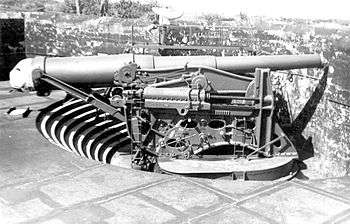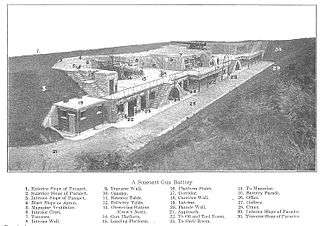Fort Armistead


Fort Armistead was a United States Army coastal defense fort, active from 1901 to 1920, that defended Baltimore, Maryland.[1]
History
Fort Armistead was built from 1897 to 1901 as part of the large-scale Endicott Program. Other forts of this era in the Coast Defenses of Baltimore include Fort Howard, Fort Carroll, and Fort Smallwood. Fort Armistead is in the Hawkins Point section of the city. The fort is named for George Armistead, commander of Fort McHenry during the British attack in the War of 1812 that inspired "The Star-Spangled Banner".[2]
Fort Armistead had four gun batteries: Battery Winchester with one 12-inch M1888 disappearing gun, Battery McFarland with three 8-inch M1888 disappearing guns, Battery Irons with two 4.72-inch 45 caliber Armstrong guns on pedestal mounts, and Battery Mudge with two 3-inch M1898 guns on masking parapet (retractable) mounts.[1] Battery Winchester was named for James Winchester, a Maryland officer in the Revolutionary War and a general in the War of 1812. Battery McFarland was named for Daniel McFarland, an officer killed in the War of 1812. Battery Irons was named for Joseph Irons, killed in the Mexican–American War. Battery Mudge was named for Robert R. Mudge, killed in action against the Seminoles.[2] The fort also included a mine casemate and command station to control a naval minefield in the harbor.[2][3]
Battery Irons had been added to Fort Armistead as part of a series of measures to quickly deploy modern weapons to the East Coast after the outbreak of the Spanish–American War in 1898.[4] The Endicott Program was still years from completion, and it was feared the Spanish fleet would bombard the US. Battery Irons was disarmed in 1913 and the guns sent to Fort Ruger in Hawaii.[2]
After the American entry into World War I in early 1917, many guns were removed from coast defenses for potential service on the Western Front. Most of these weapons were not sent overseas or did not see action; however, most of the heavy guns in the Baltimore area were dismounted in 1917–18 and not returned to the forts. Battery McFarland's three 8-inch guns were removed in 1917 for potential use as railway artillery, while Battery Winchester's 12-inch gun was sent to Fort Wadsworth, Staten Island, New York to replace a gun sent to the railway artillery program.[5] With the war over, in 1920 Fort Armistead's service came to a close; Battery Mudge's 3-inch guns were scrapped as part of a general withdrawal from service of the 3-inch M1898 gun type.[2][1]
In World War II the site was used by the Navy for ammunition storage. In 1952–54 a four-gun 90 mm anti-aircraft battery was stationed on site.[3]
Present
The fort is now a Baltimore city park. The batteries are partly buried but still visible.[2] The fort and surrounding tunnels are open to exploration, though largely abandoned by the city and covered with graffiti and garbage.[6]
See also
References
- 1 2 3 Berhow, p. 211
- 1 2 3 4 5 6 Fort Armistead article at FortWiki.com
- 1 2 Baltimore forts at NorthAmericanForts.com
- ↑ Congressional serial set, 1900, Report of the Commission on the Conduct of the War with Spain, Vol. 7, pp. 3778–3780, Washington: Government Printing Office
- ↑ Fort Wadsworth article at FortWiki.com
- ↑ https://www.yelp.com/biz/fort-armistead-park-baltimore
- Berhow, Mark A., Ed. (2015). American Seacoast Defenses, A Reference Guide, Third Edition. McLean, Virginia: CDSG Press. ISBN 978-0-9748167-3-9.
- Lewis, Emanuel Raymond (1979). Seacoast Fortifications of the United States. Annapolis: Leeward Publications. ISBN 978-0-929521-11-4.
External links
- List of all US coastal forts and batteries at the Coast Defense Study Group, Inc. website
- FortWiki, lists most CONUS and Canadian forts
Coordinates: 39°12′32″N 76°32′02″W / 39.20889°N 76.53389°W